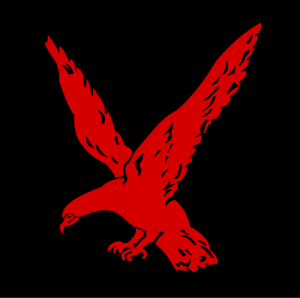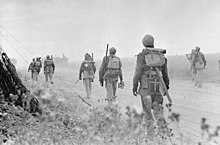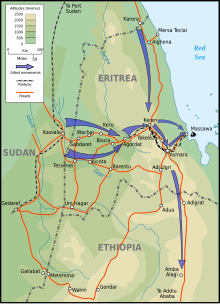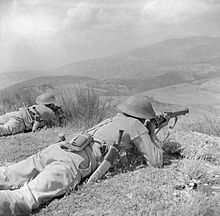4th Infantry Division (India)
| 4th Indian Infantry Division | |
|---|---|
 Insignia of the 4th Indian Infantry Division during the Second World War | |
| Active | 1939–present |
| Country | |
| Allegiance | |
| Branch | |
| Type | Infantry |
| Size | Division |
| Part of | XIII Corps (historical) I Corps (India) |
| Nickname(s) | "Red Eagle Division" |
| Engagements | Second World War Sino-Indian War Indo-Pakistani War of 1971 |
The 4th Indian Infantry Division, also known as the Red Eagle Division, is the infantry division name the Indian Army retained after the present India adopted its entire rank and structure from its parent Army, the British Army.
The division was formed in Egypt in 1939 during the Second World War.[1] As with all formations in the British Army, it primarily had British officers and a few Indians in lower ranks but had a few Indian officers with junior ranks as high as Captain. During the Second World War, it took part in campaigns in East Africa (Eritrea and Sudan), Syria, North Africa and Italy.
History[]
North Africa[]


During the war, the 4th Indian Division was in the vanguard of nine campaigns in the Mediterranean theatre. Major-General The Hon. P. Gerald Scarlett appears to have been the division's first commander, from October 1939 to January 1940. The British 14th Infantry Brigade was attached to the division from 1 June to 20 July 1940; the British 16th Infantry Brigade was attached from 9 September 1940 to 14 December 1940.[2] In the first of Archibald Wavell's operations in Egypt, as part of the Western Desert Force, it took part in Operation Compass in December 1940. The division was involved in the battles of that campaign in the camps around Sidi Barrani. Along with the 7th Royal Tank Regiment, the 11th Indian Infantry Brigade of the 4th Indian Infantry Division destroyed the Italian Maletti Group at the Nibiewa Camp.
East Africa[]

In December 1940, the division was rushed to the British Sudan to join with the 5th Indian Infantry Division in order to prevent the numerically vastly superior Italian forces (ten divisions in total) from threatening Red Sea supply routes to Egypt as well as Egypt itself and the Suez Canal from the south. The East African campaign culminated in March 1941 with the battles at Keren in Eritrea.
It was at Keren that Subadar Richhpal Ram of the 4/6th Rajputana Rifles, 5th Indian Infantry Brigade, 4th Division, was awarded a posthumous Victoria Cross.[1] In April 1941, Beresford-Peirse was promoted to command the Western Desert Force and Major General Frank Messervy assumed command.
North Africa and Syria[]
Having returned to Egypt, the 5th Indian Infantry Brigade was hurried across to Syria and participated in the advance on Damascus during the Syria-Lebanon campaign (June 1941). From 14 to 17 June 1941, the British 4th Armoured Brigade was attached to the division.[2] The rest of the 4th Indian Division, having been rejoined by the 5th Brigade returning from Syria, was involved in the fighting, which ebbed and flowed past Tobruk from June 1941 into the autumn of 1941. For most of this period, the division was dispersed, with units temporarily attached to other formations, much to the disgust of Major General Francis Tuker, who had assumed command of the Division in December 1941. Notable at this time was the break-out at the end of January by 7 Brigade, having been cut off at Benghazi during the Axis counter-offensive from Agheila and moving 200 miles avoiding the enemy to rejoin the new Eighth Army.
Early in April 1942, the 4th Division was again dispersed, with the 7th Brigade going to Cyprus, the 5th Brigade to Syria, the 11th Brigade to the Suez Canal Zone for training and the Central India Horse to Iraq after a period of training. By May 1942, the 11th Brigade was back in the fighting at Tobruk (attached to the 5th Indian Infantry Division). The 11th Brigade was caught in the siege of Tobruk, which fell on 21 June, and disappeared from the order of battle for the next 18 months. The 5th Brigade was rushed to the desert in June 1942; after escaping from Mersa Matruh, the brigade held the vital Ruweisat Ridge during the First Battle of El Alamein in July–August 1942. The situation had become so confused that General Erwin Rommel, also known as the Desert Fox, lost his way and was forced to spend a night in the open. With the dawn came the realization that he was in the company of 4th Division. With a sigh of relief, he slipped away, undetected.[3]
Shortly before the Second Battle of El Alamein in October 1942, the 4th Indian Division was reunited with the 7th Brigade returning from Cyprus and the 161st Indian Infantry Brigade was attached (until December 1942) to replace the lost 11th Brigade. The division had a relatively subsidiary role in the battle, holding in stiff fighting, as a diversionary tactic, the Ruweisat Ridge, which was at the centre of the Allied front, whilst the breakthrough was planned further north.

By December 1942, the division was dispersed again but strong representations by its General Officer Commanding (GOC), Major-General Tuker (including his asking to be relieved of command), resulted in the 4th Indian Division being brought together as a fighting entity in March 1943. It fought with distinction in the Tunisia Campaign, right through to the fall of Tunis in May 1943, gaining a particular reputation for its prowess in mountainous country. The division had the honour of capturing General Hans-Jürgen von Arnim in Tunisia, bringing an end to the war in North Africa. Its major battles in North Africa were Benghazi, Tobruk, Wadi Akarit, Enfidaville and Tunis.
Italy[]
The division then moved in January 1944 to Italy (joined by the re-constituted 11th Brigade), where it took part in the Italian Campaign. It fought in the second Battle of Monte Cassino and suffered many casualties (in Tuker's absence through illness it was commanded by Brigadier Harry Dimoline, the divisional Commander Royal Artillery). During the battle, the division was to attack in an arc towards the south and south-west, taking Point 593 and then moving south-east, up the heights towards the Abbey. The Indian Division would only advance on the Abbey once the 2nd New Zealand Division had attacked south and south-east, taking the town of Cassino.[4] The main attack eventually commenced just after last light with the NZ Division's 28 (Maori) Battalion to cross the Rapido River and to seize the station south of Cassino town, establishing a bridgehead for the corps armour to move into the town and to the foot of the Cassino massif—the attack starting at 2:130. The 28th Battalion attack failed and so did the 4th Indian Division attack on Point 593.[5]
The division also suffered many casualties during the third battle (in March 1944), when it was commanded by Major-General Alexander Galloway, who had been released from command of the British 1st Armoured Division.


Command of the division was assumed by Major-General Arthur Holworthy late in March 1944 and the division took part in the advance from Cassino after the fourth battle in May 1944 to the Trasimene Line in Central Italy and then the Gothic Line. As part of the attachments and detachments for the campaign, the British 9th Armoured Brigade was attached to the division from 8 July 1944 to 19 July 1944.[2] In November 1944, the division was shipped to Greece to help stabilise the country after the Axis withdrawal.[6] Holworthy was succeeded by Major-General Charles Hamilton Boucher in January 1945 who commanded the division until the end of hostilities.
Conclusion[]
According to author Chand Das, during the Second World War, the "division captured 150,000 prisoners and suffered 25,000 casualties, more than the strength of a whole division. It won over 1,000 honours and awards which included four Victoria Crosses and three George Crosses".[6]
Field Marshal Lord Wavell wrote: "The fame of this Division will surely go down as one of the greatest fighting formations in military history, to be spoken of with such as The Legio X Equestris (Tenth Legion), The Light Division of the Peninsular War and Napoleon's Old Guard". Das wrote, "Even beyond its fighting reputation, it will be remembered for the spirit of mutual trust and fellowship maintained between all ranks coming from so many different races and creeds".[6]
Formation during World War II[]
The unit listing is from a booklet issued to mark the inauguration of the Indian Divisions' Memorial 1939–1945 at RMA Sandhurst in June 1982.
General Officer Commanding:
- Major-General The Hon. P. Gerald Scarlett (Oct 1939 – Jan 1940)
- Major-General Philip Neame (Feb – Aug 1940)
- Major-General Noel Beresford-Peirse (Aug 1940 – Apr 1941)
- Major-General Frank Messervy (Apr – Dec 1941)
- Major-General Francis Tuker (Dec 1941 – Feb 1944)
- Brigadier Harry Dimoline (Feb – Mar 1944)
- Major-General Alexander Galloway (Mar 1944)
- Major-General Arthur Holworthy (Mar 1944 – Jan 1945)
- Major-General Charles Boucher (Jan – Aug 1945)
Headquarters[]
- Central India Horse (up to April 1942 and from July 1944) (Divisional Reconnaissance Regiment)
- Royal Artillery
Commanders divisional artillery:
- Brigadier Noel Beresford-Peirse
- Brigadier P. Maxwell (Jun – Sep 1940)
- Brigadier William H.B. Mirrless (Sep 1940 – Mar 1942)
- Brigadier Harry Kenneth Dimoline (Mar 1942 – Feb 1944)
- Brigadier John F. Adye (Feb 1944 – Mar 1944)
- Brigadier Henry C.W. Eastman (Apr 1944 – )
- HQ
- 3rd Regiment Royal Horse Artillery
- 1st, 4th, 11th, 25th, 31st and 32nd Field Regiments, RA
- 57th (King's Own Yorkshire Light Infantry) Light A.A. Regiment, RA
- 35th and 149th Anti-Tank Regiments, RA
- Indian Engineers: Sappers and Miners
- 4th Field Company, King George's Own Bengal Sappers and Miners
- 12th Field Company, Queen Victoria's Own Madras Sappers and Miners
- 18th and 21st Field Company, Royal Bombay Sappers and Miners
- 11th Field Park Company, Queen Victoria's Own Madras Sappers and Miners
- 4th Indian Division Signals
- 1st Battalion, Royal Northumberland Fusiliers (Machine Gun) (April–December 1940)
- Machine Gun Battalion, 6th Rajputana Rifles (1942–1945)
5 Indian Infantry Brigade[]
- HQ 5th Indian Infantry Brigade
- 1st Battalion, Royal Fusiliers (up to Sept 1941)
- 1st Battalion, Buffs (Royal East Kent Regiment) (from Sept 1941 to Dec 1941))
- 1st Battalion, Welch Regiment (from Dec 1941 up to April 1942)
- 1/4th Battalion, Essex Regiment (from April 1942)
- 1st Battalion, 1st Punjab Regiment (up to April 1942)
- 3rd Battalion, 1st Punjab Regiment
- 4th Battalion (Outram's), 6th Rajputana Rifles (with 11th Indian Infantry Brigade in Italy)
- 3rd Battalion (Queen Mary's Own), 10th Baluch Regiment (from April 1942)
- 1st Battalion, 9th Gurkha Rifles
7 Indian Infantry Brigade[]
- HQ 7th Indian Infantry Brigade
- 1st Battalion, Royal Sussex Regiment
- 2nd (Royal) Battalion, 11th Sikh Regiment
- 4th Battalion, 11th Sikh Regiment (up to April 1942)
- 4th Battalion, 16th Punjab Regiment
- 1st Battalion, 2nd King Edward VII's Own Gurkha Rifles (The Sirmoor Rifles) (from April 1942)
11 Indian Infantry Brigade (1939–1942 and 1944–1945)[]
- HQ 11th Indian Infantry Brigade
- 2nd Battalion, Queen's Own Cameron Highlanders
- 2nd Battalion, 5th Mahratta Light Infantry (up to June 1942)
- 1st Battalion (Wellesley's), 6th Rajputana Rifles (up to April 1942)(with 5th Indian Infantry Brigade in Italy)
- 4th Battalion, 7th Rajput Regiment (up to January 1942)
- 3rd (Royal) Battalion, 12th Frontier Force Regiment
- 3rd Battalion, 14th Punjab Regiment (from January 1942)
- 2nd Battalion, 7th Gurkha Rifles (from April 1942)
- Lovat Scouts
Support units[]
- Royal Indian Army Service Corps
- 4th Indian Division Troops Transport Company
- 5th, 7th and 11th Brigade Transport Companies
- 220th Indian DID
- Medical Services
- I.M.S-RAMC-I.M.D-I.H.C-I.A.M.C
- 14th, 17th, 19th, 26th and 32nd Indian Field Ambulances
- 4th Indian Division Provost Unit
- Indian Army Ordnance Corps
- 4th Indian Division Ordnance Field Park
- Indian Electrical and Mechanical Engineers
- 117th, 118th and 119th Infantry Workshop Companies
- 4th Indian Division Recovery Company
Assigned brigades[]
All these brigades were assigned or attached to the division at some time during World War II.[7]
- 4th New Zealand Infantry Brigade
- 10th Indian Infantry Brigade
- 22nd British Infantry Brigade
- 23rd British Infantry Brigade
- 161st British Infantry Brigade
- 1st South African Infantry Brigade
- 161st Indian Infantry Brigade
- 201st Guards Motor Brigade
- 11th Canadian Infantry Brigade
Postwar[]
The Division, known as Red Eagle due to its badge of a red eagle on a black background, is now a part of the Indian Army. Immediately after the war ended it was in Greece, but returned to India later in 1945.
In 1947 the division became the nucleus of the Punjab Boundary Force under Major-General T.W. Rees.[8] The Boundary Force was established on 17 July 1947, with its headquarters at Lahore. It became operational 1 August 1947, but was disbanded on 1 September because of its ineffectiveness in controlling the riots breaking out as a consequence of Partition. It had approximately 15 Indian and 10 Pakistani battalions, and comprised 5th Indian Infantry Brigade, 11th Indian Infantry Brigade, 14 Parachute Brigade, which became part of the Pakistan Army, 43 Lorry Brigade (ex 1 Armoured Division) and 114th Indian Infantry Brigade. Also attached were 50th Parachute Brigade and 77th Parachute Brigade (both formerly with 2nd Airborne Division), and 123rd Indian Infantry Brigade. After Rees handed over, Major-General K. S. Thimayya reportedly took over command of the Boundary Force. The Division moved to Jullunder after the Boundary Force was disbanded.
Elements fought in the Sino-Indian War of 1962. Before the war the division comprised 5th Indian Infantry Brigade, 7th Infantry Brigade, and 11th Indian Infantry Brigade.[9] 7th Indian Infantry Brigade was effectively destroyed at the Nam ka Chu ridge during the war.[10] It was converted to a mountain division in 1963 and fought in the 1965 war.[11]
It also fought on the Bangladesh front during the Indo-Pakistani War of 1971. It consisted of 7, 41, and 62 Mountain Brigades, and also included A Squadron, 45 Cavalry.[12] Coming under the I Corps (India) and Central Command, the division is headquartered in Allahabad.
Notes[]
- ^ Jump up to: a b Das 1996, p. 379.
- ^ Jump up to: a b c "Division Subordinate Units". Archived from the original on 24 March 2020. Retrieved 26 July 2010.
- ^ Reagan 1992, p. 19.
- ^ Molony 2004, p. 712.
- ^ Ellis 1984, pp. 185, 191.
- ^ Jump up to: a b c Das 1996, p. 380.
- ^ "4 Division units". Order of Battle. Retrieved 22 October 2009.
- ^ Ravi Rikhye and Mandeep Bajwa, 4th Infantry Division: An Outline History Archived 14 June 2011 at the Wayback Machine, V3.0, 25 March 2008, www.orbat.com (Centre for Indian Military History), accessed 1 August 2010
- ^ "The Indian Army on the eve of the 1962 War" (PDF). Archived from the original (PDF) on 28 November 2010. Retrieved 26 July 2010.
- ^ "India 7th Infantry Brigade at the Battle of the Namkachu 1962". 31 March 2002. Archived from the original on 14 April 2012. Retrieved 30 September 2013.
- ^ Conboy 1992, p. 8.
- ^ Gill 2003, p. 71.
References[]
- Anon (1946). The Tiger Triumphs: The Story of Three Great Divisions in Italy. HMSO.
- Conboy, Kenneth (1992). Elite Forces of India and Pakistan. Elite No. 41. London: Osprey. ISBN 9781855322097.
- Das, Chand (1996). "Indian Infantry Divisions in World War II – Part I". Journal of the United Service Institution of India. CXXVI (525: July/September 1996): 374–387.
- Ellis, John (1984). Cassino: The Hollow Victory. London: Andre Deutsch.
- Gill, John H. (2003). An Atlas of the 1971 India – Pakistan War: The Creation of Bangladesh. Washington D.C: Near East South Asia Centre for Strategic Studies (National Defense University). OCLC 53906774.
- Mackenzie, Compton (1951). Eastern Epic. London: Chatto & Windus. OCLC 1412578.
- Mason, Philip (9 June 1982). The Indian Divisions Memorial, 1939–1945, Royal Military Academy Sandhurst. Wellingborough: Skelton's Press.
- Molony, Brigadier C.J.C.; with Flynn, Captain F.C. (R.N.); Davies, Major-General H.L. & Gleave, Group Captain T.P. (2004) [1st. pub. HMSO:1973]. Butler, Sir James (ed.). The Mediterranean and Middle East, Volume V Part 1: The Campaign in Sicily 1943 and The Campaign in Italy 3rd September 1943 to 31 March 1944. History of the Second World War, United Kingdom Military Series. Uckfield, UK: Naval & Military Press. ISBN 1-84574-069-6.
- Reagan, Geoffrey (1992). Military Anecdotes. Guinness Publishing. ISBN 0-85112-519-0.
- Yeats-Brown, F (1945). Martial India. London: Eyre and Spottiswoode.
- "Orders of Battle.com". Archived from the original on 30 September 2007. Retrieved 2 September 2007.
External links[]
- Indian World War II divisions
- Divisions of the Indian Army
- British Indian Army divisions
- Military units and formations established in 1939
- Military units and formations of the British Empire in World War II
- Military units and formations in British Somaliland in World War II